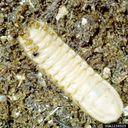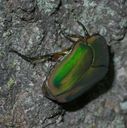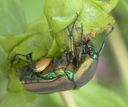Cotinis
Cotinis
Classification
- Phylum: Arthropoda
- Subphylum: Hexapoda
- Class: Insecta
- Order: Coleoptera
- Suborder: Polyphaga
- Superfamily: Scarabaeoidea
- Family: Scarabaeidae
- Subfamily: Cetoniinae
- Tribe: Gymnetini
- Genus: Cotinis
Pronunciation
How to pronounce Cotinis: /koʊˈtɪnɪs/
These audio files are automatically generated. While they are not always 100% accurate, they are a good starting point.
Images






Summary
Cotinis is a genus of beetles in the family Scarabaeidae, including the green June beetle (Cotinis nitida), known for its metallic coloration and agricultural impact. It has a life cycle that spans a year, with both larval and adult stages exhibiting predatory interactions.
Physical Characteristics
Usually velvety green with brownish highlights and some areas of metallic green, sometimes jet black. Clypeus with horn-like process at apical margin. Scutellum not visible (covered by the base of pronotum). Adults are usually 15–22 mm long with dull, metallic green wings and bright shiny green legs and underside.
Identification Tips
Distinguished from similar beetles by larger body size (14-34 mm) and vibrant coloration. The male species has a small horn on the lower portion of the face (clypeus).
Habitat
Commonly found in lawns, fields, and forests, particularly in garden-like areas with decomposing plants. Prefers older fields with high organic matter.
Distribution
New World; most diverse in Mexico. In the United States, found from New Brunswick to Georgia, and as far west as California, with possible population crossover with Cotinis mutabilis in Texas.
Diet
Adults feed on fruits such as berries, grapes, peaches, nectarines, apples, pears, and figs, and are particularly attracted to rotting fruit. Larvae feed on humus and mold, causing damage to plant root systems.
Life Cycle
The complete life cycle lasts about one year. Mating occurs in the early morning with females laying 60-75 eggs underground within two weeks. Eggs hatch into grubs, which grow through three larval stages before pupation.
Reproduction
Mating occurs in the early morning; females lay eggs underground in moist organic matter. Eggs hatch into white grubs that develop over the year.
Predators
Natural predators include birds such as robins, blue jays, and brown thrashers. Larvae also face predation from moles and various vertebrates when underground and during surface emergence.
Ecosystem Role
The larvae can cause significant damage to the roots of ornamental plants and crops, while adult beetles help break down decomposing fruit.
Economic Impact
Cotinis nitida can cause agricultural damage, necessitating pesticide use, which may lead to increased costs for water purification and affect livestock health.
Similar Taxa
- Cotinis mutabilis (figeater beetle)
- Common brown May beetle
Misconceptions
Often confused with other beetles such as the May beetle, though they are distinguished by size and coloration.
Tags
- beetles
- Cotinis nitida
- green June beetle
- insecta
- scarabaeoidea